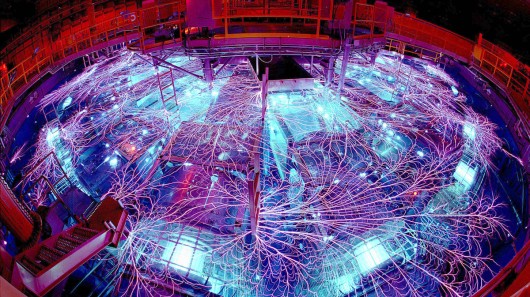Sandia simulation suggests sunny skies for fusion reactors
By Brian Dodson
02:15 April 2, 2012
In the beginning, there was the thermonuclear bomb - mankind had harnessed the energy of the Sun. Confident predictions abounded that fusion reactors would be providing power "too cheap to meter" within ten years. Sixty years later many observers are beginning to wonder if billions of dollars of effort has been lost in digging out dry wells. Now a new simulation study carried out at Sandia National Laboratories in Albuquerque, New Mexico, suggests that magnetized inertial fusion (MIF) experiments could be retrofitted to existing pulsed-power facilities to obtain fusion break-even.
Fusion power results from combining the nuclei of light atoms to make heavier ones, while in the process releasing ~1% of their mass-energy. Research on controlled fusion power has focused primarily on two paths - magnetic confinement fusion and inertial confinement fusion.
In magnetic confinement fusion, a very low density plasma is held at perhaps 200 million degrees K for about a second. In inertial confinement fusion, an enormously dense (~ 100 times the density of solid lead) is enormous, and rapid compression to that density produces a hot plasma, but the confinement time is only about a nanosecond.
Neither approach has demonstrated break-even performance - where the fusion power released is greater than the energy required to establish and maintain the fusing plasma.
Magnetized Inertial Fusion
The magnetized inertial fusion method works like this. A sample of mixed deuterium-tritium gas is placed in a small conducting cylindrical target. The target is placed in an extremely strong axial magnetic field (typically tens of Tesla in intensity). A pulsed laser is used to heat the sample gas, following which the cylinder is subjected to rapid radial compression, either by an imploding laser pulse or by an extremely strong current. Fusion follows.
Among the benefits of this approach to fusion power are that the axial magnetic field makes the collapsing cylinder resist linear instabilities, so the compression is quite uniform across the sample. During compression, the axial magnetic field becomes tangled near the ends of the cylinder, which serves to further trap the sample and prevent an otherwise large axial loss of heat.
Sandia National Laboratories' Z-accelerator (Z for short) is an ideal platform upon which to test out magnetized inertial fusion. Designed as an intense X-ray source for testing nuclear weapon components, Z can deliver an electrical pulse with a sizable fraction of a petawatt of power for a duration of a tenth of a microsecond to a region about the size of your little finger. The axial magnetic field for the MIF experiment is supplied by a pair of coils energized just prior to the experiment by a 2.2 megajoule capacitor bank, supplying a field of about 10 Tesla. After heating the sample gas with an external laser pulse, the Z is discharged across the cylinder.
Such tests are currently being prepared. Sandia's simulation of the soon-to-be-carried out tests were intended to discover if the likely enhancement of fusion reaction rate was likely to be a small effect or a large effect (previous analysis had suggested a small effect was more likely). To their surprise, they found that in a situation where the cylinder was compressed by 60 mega-amperes of current, the process yielded about 100 times break-even performance. Increasing the current to 70 mega-amperes produced 1000 times break-even - a level at which the ratio between power taken from the power grid to run the apparatus would be less than the power returned to the power grid - in excess of true break-even performance.
Sandia researchers are preparing experimental tests of the MIF technique. They will begin at smaller compression currents, as the Z can only deliver 26 mega-amperes with which to compress the cylinder. However, we continue to hope for encouraging results ahead.
Source: Sandia National Laboratories
Copyright © gizmag 2003 - 2012 To subscribe or visit go to: http://www.gizmag.com
